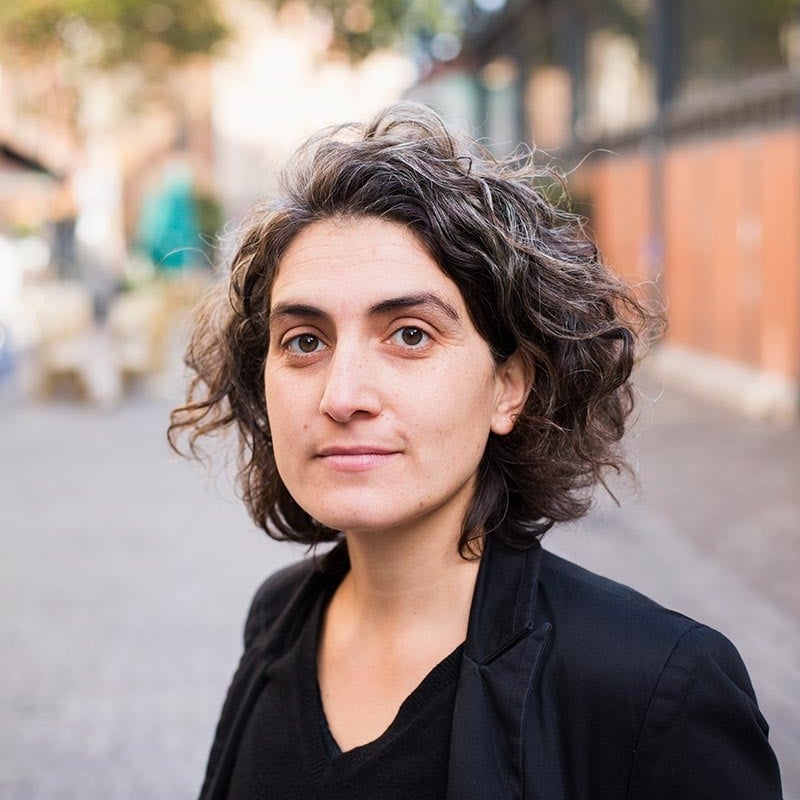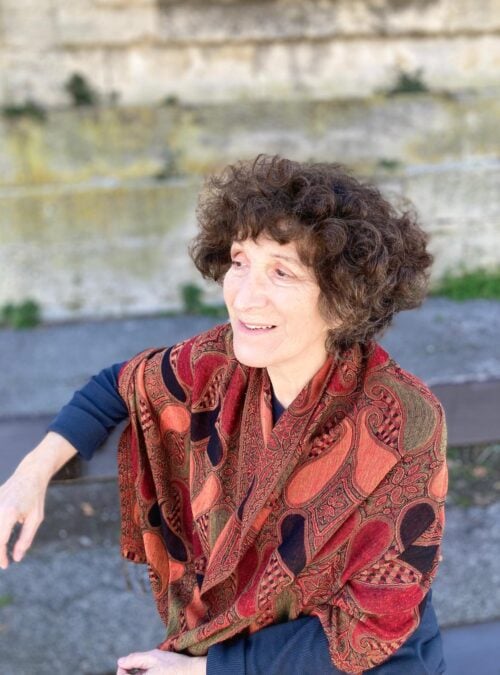Translating with constraints. Interview with Brune Seban, translator of Zerocalcare
Author: Thea Rimini, Université de Mons

A translator of comic books and an expert in subtitling, Brune Seban is specialised in translating with constraints, combining a passion for Italy and a spirit of activism.
You are now the official translator for France of the Zerocalcare comic book phenomenon, but how did you start translating his comic books?
At that time I was living in Rome, working for television, translating subtitles for Italian films presented at French festivals, such as Cannes or Villerupt. When I left Rome in 2013, I took a course on literary translation in Switzerland. The aim was to end the training with a very specific translation project: I called Zerocalcare’s publishing house [Bao Publishing] to ask if they had sold the rights to Forget My Name in France. They said they hadn’t, but informed me that they had just sold the rights to the next comic book, Kobane Calling, which had not yet been released in Italy.
I then contacted the French publishing house that had bought the rights, pointing out that I shared the same background as Zerocalcare and knew all his cultural, political, and social references. I was lucky, because the person worked for the publishing house was Italian, and knew how important this element was for the author. She asked me to do a trial translation, which went well, and here I am translating Zerocalcare.
What are the skills one needs to translate comics? Can you tell us about the differences between translating a novel or a short story and translating a comic book?
Coming from the world of subtitling, the aspect I find most interesting is that of having to deal with very tight constraints. Translating means constantly making choices and the fact of having several constraints gives us very little leeway, as it were.
Obviously, in comic books it is the balloon that imposes restrictions; in Zerocalcare, however, there are even more restrictions, as the author plays a lot with the size of the text. A line typed in a small font indicates a character speaking softly, while a large font indicates that a character is speaking loudly. So you have to pay a lot of attention to the length of the translation, as otherwise the draughtsman may, finding text written in a small font, enlarge it so that it can fit into the balloon, and thus give the impression that the character is shouting when in reality he is not, or vice-versa.
In addition to the ‘physical’ constraint, linked to space, with Zerocalcare the issue is further complicated because it is the author who draws, and it is the author who writes the lettering: in short, for him drawing and text are one and the same. The French publisher [Cambourakis] approached a graphic designer to find a typeface that would reproduce Zerocalcare’s writing so that it was the same as the original, so that the whole thing could be conceived as an image.
So there is a close collaboration between you and the graphic designer?
I am actually obsessed with the issue of size. The end result must be as homogeneous as possible, in terms of proportion between text and image. That is why only when I receive the page layout do I often realise that the word I used is correct. This re-reading phase is essential to me.
The language used by Zerocalcare, however, poses additional difficulties, which are not only related to the format of the comic, but also to words and meanings
I recently took part to a round table with comic book translators (this was at the VO-VF festival in Gif-sur-Yvette) where translator J.-B. Coursad pointed out that the most complicated aspect of this type of translation is the use of a contemporary, not strictly literary language, a language that differs from what he called the ‘timeless language’ of literature. This is all extremely pertinent to Zerocalcare. What is fascinating, when translating his books, is precisely having to deal with his language, with phrases infused with a vocal, spoken quality, and turn out to be far more complicated than they seem. Zero gives you the impression of total simplicity, a writer who talks straight and writes as he speaks’, but this is an illusion. It is a language all of its own, where Italian is woven through with the Roman dialect with endless ingenuity. One must fully understand every aspect of his language in order to translate it. Let me give you an example: as I read again a now published translation, I realised that I had mistranslated the expression ‘I am not as refined as you, starched poppies‘. I was very clear about the sense of stiffness conveyed by the image, but I hadn’t grasped the fact that the ‘poppies’ were ‘the comrades’, the comrades who turned bourgeois.
How do you work with the Roman dialect?
First of all, I analyse the text. In translation, one has to reproduce the same effect that the Italian reader would have when reading Zerocalcare’s comics, or rather choose between several possible effects. I must also bear in mind that his Roman dialect is not wholly foreign to Italians; therefore, I thought it was important to use a working-class language. My aim is to give the comic strip a language that is as little dull as possible, but without resorting to French argot. Roman dialect is actually quite stable, whereas French argot changes all the time. The question we translators ask ourselves is always the same: is it OK to use words that will quickly go out of fashion? Then there is the question of foreignness: for most Italians, some of the expressions used by Zero remain strange or even incomprehensible. If I start from the idea that I have to recreate the same effect on the French reader, I have to look for something unusual. I therefore decided to keep some words in Roman dialect, and include a glossary, which I added at the end of the book so as not to make reading cumbersome. In this paratext I added explanations for political references such as the G8 held in Genoa or the community centres (an expression I could have translated as ‘squat’ but I decided to leave it in Italian because it does not translate into the same thing). Once the translation was published, I wondered whether the lexical choices I had made for that album would be relevant for all the others. In fact, I think that for the next book I will not use a lexicon because it would risk becoming a bit affected.
Another issue I have to deal with when translating Zero concerns any text embedded in images, like slogans on the walls or stickers with writing, placed around a character’s bedroom. I confess that this is a problem I have yet to solve. At first I translated them, but now I am no longer convinced of this choice because being in an Italian teenager’s room with writing in French can feel discordant. Now I use a lot more translator’s notes, but when I started it was not an accepted practice. At the end of the day, everything always revolves around the same question: is the image part of the things to be translated or not?
During your translation work did you have any contact with Zerocalcare?
We met once and talked because we had things in common – he, like me, translated subtitles for films before he became famous – and then we wrote to each other. For the first translation he helped me a little, but little by little he stopped answering my queries, he no longer had any time to. So I often ask Italians and Romans for advice; I ask them what they think when they read a certain passage. However, I know that Zero had his French friends read my first translation and that they liked it. He says his French stops in the 1990s, he does not master contemporary French.
You have translated all of Zerocalcare, but in fact for La Prophétie du Tatou it is a retranslation: the volume was first published in 2014 by Paquet…
In France, translations don’t follow the order in which comic books are published in Italy. The first book I translated was Kobane Calling and then, when The Prophecy of the Armadillo was republished in Italy, enriched by a beautiful preface and afterword, the publisher and I wondered whether we should only translate the new texts or retranslate the entire volume. Since the style of the first translation is very different from mine, we opted for the second option.
His new translation was much more successful than the first translation. Could we say that a new translation is like a new book?
I honestly cannot assess the impact of the translation itself: there are many factors to take into account that lead to the success of a book. I do think, however, that Cambourakis’ support was crucial. Whether the translation equates to a new book, this is difficult to say…Undeniably language plays an important part even though, in comic books, it is the image that plays the central role.
Back to comics in general, what difficulties does a translator of Italian comics have to deal with?
Italian comic books are very much influenced by American comics, their codes are closer to their American counterparts, unlike the French production. For example, all onomatopoeic terms are American, and for Italian readers this is normal, they are used to it. In France, on the other hand, the same wouldn’t work. It’s a real conundrum: do we keep the Italian style, which is an ‘American Comics’ style, or do we adapt it for the French reader?
Before translating comics, you worked for a long time in subtitling. Can you tell us how you embarked in this type of work?
I studied literature and sociolinguistics. Since my father is Italian and I lived in Italy when I started primary school, I graduated in Italian in France and then returned to Rome through the Erasmus programme. I came across subtitling because I was simply looking for a job. The number of constraints this type of translation entails is enormous, and not only because the number of characters is strictly defined, but especially because you cannot re-read the material. In addition, each line must be translated in the same order spoken by the character, and not according to a logical order. When I worked in subtitles, my main objective was to make the viewer understand the social background of the characters. For contemporary films, you also have to use a very contemporary language and in Italian cinema there is the additional problem of local dialects.
Can you render dialects in subtitles?
No, it really is too difficult, and I certainly wouldn’t use a regional variety of French. Of course, if there are characters who speak in dialect, and because of that they don’t understand each other, then you have to find a way to convey this communication problem to the viewer.
Do directors usually get involved in subtitling?
It is very rare, although it is nice when it happens. Marco Bellocchio did show an interest in his films’ subtitling. He came to see us when we were working on Vincere and I remember he asked us a lot of questions.
Actually, there are two separate worlds: the realm of subtitles for cinema and that of subtitles specifically for film festivals. I only worked for film festivals, where you often have very limited time, and in Italy you are not even well paid. For the Cannes film festival, for example, it’s crazy: the films they show are very expensive, but we only had a week to translate all the subtitles. Probably in France, the translation of subtitles works differently.
In addition to your work as a translator, you are an activist in the LGBQT movement. Do you think it is possible to produce an activist translation – a feminist translation, for example, as Susanne de Lotbinière-Harwood and Luise von Flotow would argue? For them, translation is ‘comme une activité politique visant à faire apparaître et vivre les femmes dans la langue et dans le monde’.
The translator is first and foremost a reader. I think that one can do anything in a feminist manner. It depends on what you are talking about: are you talking about the fact that one can be sensitive to something that has a clear feminist component in the original text and has not been given the same meaning in the translation? I have sometimes read translations that did not capture the political meaning that I read in text – this is for example true of translation choices that are due to the translators’ lack of knowledge of LGBQT culture. This doesn’t mean that they are bad translations, but I think there can be translation errors. With minority cultures, the problem is that there aren’t many translators who are familiar with them, recognise them, and consequently manage to take them into account.
Have you ever made any feminist or LGBQT alterations (additions to the original text, for example) to your translations?
Once again, it is a question of translation. What impact did the text have on the original audience? And what impact would I like it to have on the audience reading the translation? Zerocalcare is an activist writer, one who stated many times he doesn’t want to reinforce gender stereotypes or use homophobic slurs (even though they are very common in both Italian and French). So I think it is correct to pay attention to these aspects and possibly make additions in this direction. I did it precisely because I felt it was consistent with the gist of his message: I used words with a feminist connotation that could resonate with a certain community, with a certain minority culture. Translation is not only a bridge from one language to another: the question of cultural transference is key.










